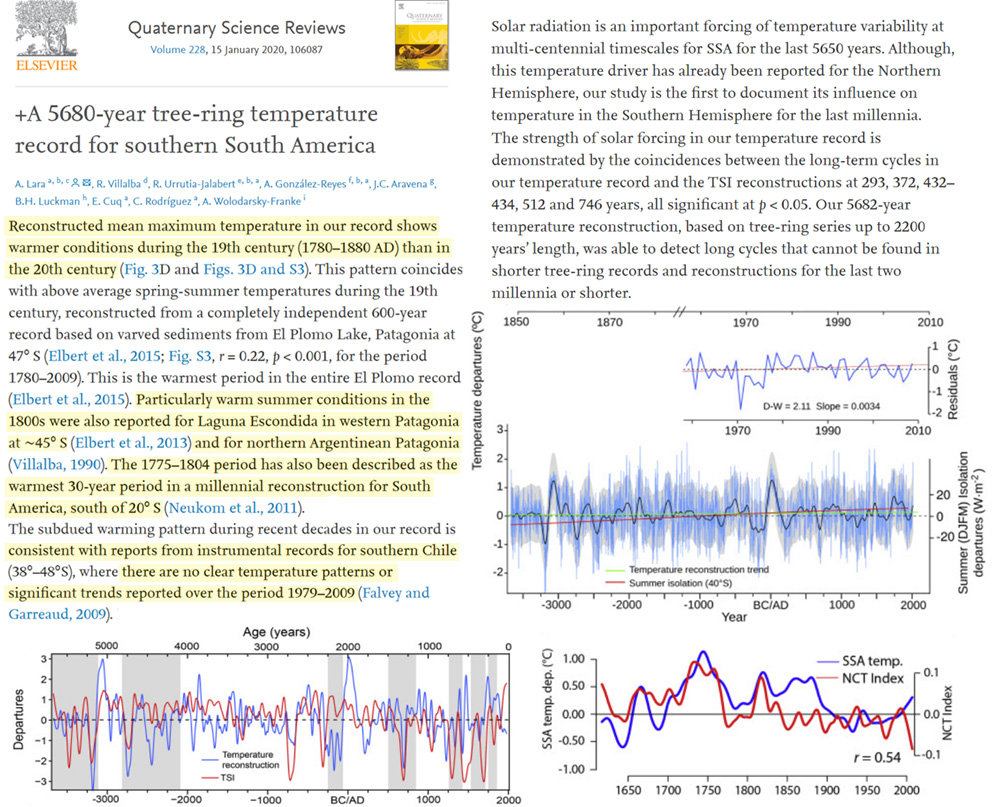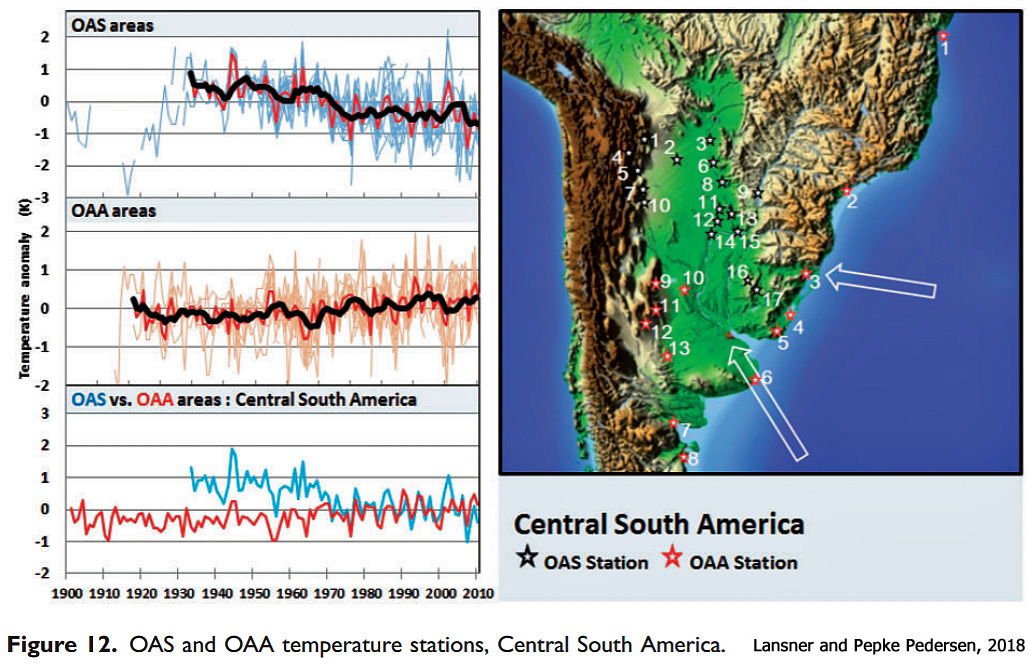By Kenneth Richard
A new 5680-year tree-ring temperature reconstruction for southern South America (Lara et al., 2020) reveals (a) no clear warming trend in recent decades, and (b) the 18th and 19th centuries (and many centennial-scale periods from the last 5680 years) had much warmer temperatures than today.

Image Source: Lara et al., 2020
In addition to finding modern temperature changes in southern South America fall well within the range of natural variability in the context of the last 5680 years, Lara et al. (2020) assess solar forcing to have contributed to climate variations for this region of the Southern Hemisphere.
The authors find CO2 fertilization can explain trees’ improved water use efficiency and tree-ring growth in general; this affects the capacity for tree-rings to be a proxy for long-term temperature variability.
They emphasize this composite tree-ring record is “the longest in the Southern Hemisphere.”
Lara et al., 2020
“The most outstanding features in the reconstruction presented here are two major warm periods between 3140–2800 BC and 70 BC – 150 AD (5159–4819 and 2089–1869 years ago, respectively, counted from 2019 to facilitate comparisons with glacier records based on 10Be dated moraines). During these warm periods, no glacier advances have been reported for Patagonia (Aniya, 2013; Kaplan et al., 2016; Strelin et al., 2014, Fig. 5A).”
“Reconstructed mean maximum temperature in our record shows warmer conditions during the 19th century (1780–1880 AD) than in the 20th century (Fig. 3D and Figs. 3D and S3). This pattern coincides with above average spring-summer temperatures during the 19th century, reconstructed from a completely independent 600-year record based on varved sediments from El Plomo Lake, Patagonia at 47° S (Elbert et al., 2015; Fig. S3, r = 0.22, p < 0.001, for the period 1780–2009). This is the warmest period in the entire El Plomo record (Elbert et al., 2015). Particularly warm summer conditions in the 1800s were also reported for Laguna Escondida in western Patagonia at ∼45° S (Elbert et al., 2013) and for northern Argentinean Patagonia (Villalba, 1990). The 1775–1804 period has also been described as the warmest 30-year period in a millennial reconstruction for South America, south of 20° S (Neukom et al., 2011).”
“The subdued warming pattern during recent decades in our record is consistent with reports from instrumental records for southern Chile (38°–48°S), where there are no clear temperature patterns or significant trends reported over the period 1979–2009 (Falvey and Garreaud, 2009).”
Consistent with the patterns documented in this paper, low frequency reconstructed cold temperature anomalies for the NH and periods of minimal solar activity were variable with periods of coincidences and discrepancies during the last 1200 years (Anchukaitis et al., 2017). Changes in large scale NH circulation are thought to provide a possible mechanism for these differences (Anchukaitis et al., 2017). The two major periods with positive anomalies in our reconstruction (3140–2800 BC and 70 BC-150 AD), coincide with positive anomalies of solar irradiance, but the deviations in the TSI are proportionally smaller in the latter period (Fig. 5A).
“A strong CO2 fertilization effect has been the main explanation for the significant increase in water-use efficiency (WUE) reported for Northern Hemisphere temperate and boreal forests over the recent two decades (Keenan et al., 2013).”
“The increasing growth trend and decreasing isotope discrimination in Fitzroya have been attributed to a raise in photosynthetic rates, which has been caused by increased CO2 and/or higher surface radiation, the latter associated with a reduction in cloudiness in a high precipitation area (Urrutia-Jalabert et al., 2015a). In the eastern slope of the northern Patagonian Andes, Argentina, under lower rainfall and cloudiness than in the Chilean western slope, a marked increase in Fitzroya tree-ring growth during the 20th century has also been recorded and attributed to increased CO2 concentration (Lavergne et al., 2018). The coincident Fitzroya growth patterns in two areas of contrasting cloud cover is an additional support for the attribution of CO2 fertilization in this species.”
For good measure, Lara et al., (2020) point out that “a cooling trend has been reported along the Pacific coast (17° – 37° S) of South America for the periods 1979–2006 and 1981–2012 (Falvey and Garreaud, 2009; Hartmann et al., 2013).”
This cooling record is consistent with instrumental records from the dozens of temperature stations all across the central and southern regions of South America which also show cooling/no warming in recent decades (Lansner and Pepke-Pedersen, 2018).





